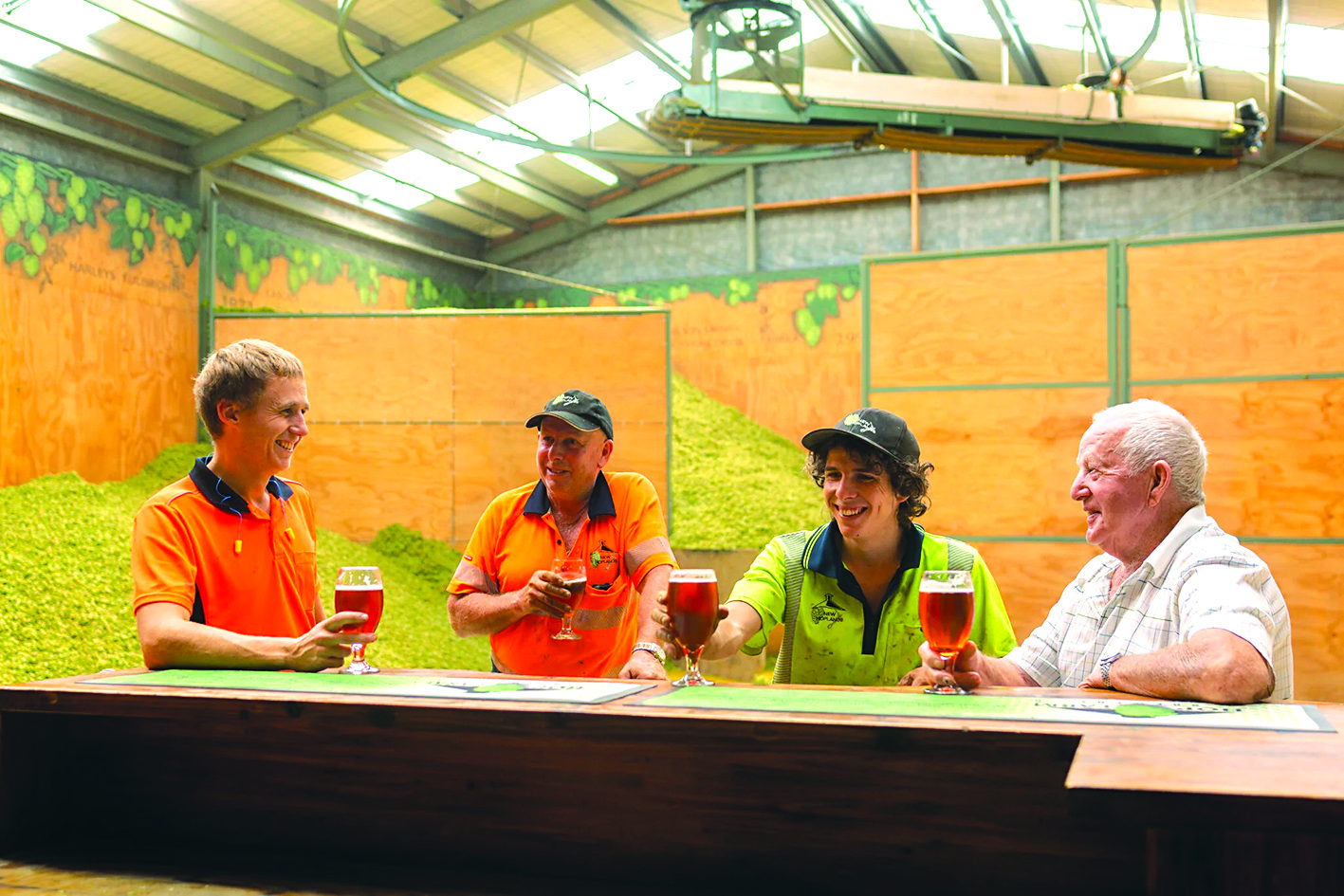Hops, hops and more hops

The Oldham family - Hayden, Colin, Thomas and David. Photo: Supplied.
The Nelson and Tasman region has ideal climatic conditions for hop farming. The region has some of the most sought-after hops in the world, with unique flavours that brewers, with a taste for something different, look for.
Hops were first grown in the Nelson and Tasman regions in 1842 and by the 1850’s local breweries had established large hop gardens. Harvest, labour intensive work picking the hops, was done by women and children. By the 1870’s farmers started to grow hops as a cash crop to enable them to clear areas of bush or purchase more established properties. The market was volatile, and prices were poor when supply was too high. Buxton and Co. a leading Nelson merchant organised marketing in New Zealand, Australia and Britain and the crops were exported.
From the 1890’s until the 1970’s, the area planted in hops in New Zealand remained around 590-690 hectares. Statistics from 2021 indicate that the total hop growing area in New Zealand is 1,945 acres compared with approx. 1,200 acres in 2012.
The Oldham’s are long time hop famers in the TadmorValley, Tapawera. “Grandad had a hop garden back in 1953, back then the whole region was scattered with lots of little hop and tobacco farms,” says Colin Oldham. “It wasn’t exported either just supplied to local market.” Over time the Oldham’s purchased neighbouring raspberry properties and converted them to hops and today they have 38 hectares of hops as well as 29 hectares in Ngatimoti.
“I’m very passionate about hops, I love the fact you can grow the plant and see it right through to the finished product,” Colin explains “The best part of being a grower is meeting the people who receive the hops. The American brewers come over every year, visit the farms and sniff all the hops to decide which ones they like.” Another highlight for Colin has been having his two sons, voluntarily, work in the family hop business. This has made a fourth generation of Oldham’s on the hop farm. “It’s one of the things that makes its all worth it.” he smiles.
Colin’s father was the first hop farmer in the nation to use the tipping-floor kilning system after studying it, in use, in Tasmania. It wasn’t long until others in the area saw the benefits and started to use the same system.
Colin says that the recent harvest was overall an ‘average’ one. “It was a good season for picking, the weather was good, we had some great aromas.”
He is realistic about the current imbalance with supply and demand and realises that the industry has reached a surplus of hops in the market, outpacing usage. All over the world hop growers have been building up a surplus of hops that has finally reached saturation. Colin says, “Hop growers are going to have to make some decisions – we have some unique varieties different to other flavours you can get overseas, however everyone is coming up with different types.”
There are currently four local hop groups competing for market share. The market has been in decline since the Covid epidemic and with the world hop surplus there will be cutbacks in production of hops. Growers cannot afford to produce hops without sales for long. With increased inflation costs, high interest rates mixed with declining sales some growers could be vulnerable.
Kim McGlashen, a Motueka hop farmer with a long history of hop industry involvement, said that this season’s harvest was ‘An easy one from the weather perspective, the hops were excellent quality and we had average volumes. There are a few hops left hanging around the district that haven’t got sales. Unless buyer interest is confirmed with forward contracts there is little reason to plant more hops – brewers are spoilt for choice.” America is currently reducing area in response to the world hop surplus.
The 2,000 tonnes of hops our nation produces each year only accounts for under 2% per cent of total hop volume used around the world. About 85 per cent of the harvest is exported to more than 20 countries round the world, generating almost $50 million in revenue. Our local hops are exported in mainly pellet form. Hop pellets are simply whole cone hops that have undergone a special pelletisation process. The whole hops are stripped from the bines during harvest, dried and then processed into firm pellets. Pelletised hops take up less space, pellets are vacuum packed, so they oxidize more slowly which means they stay fresh longer and have a better flavour for longer. “Our region moved to pelleting hops specifically for export in the early 1980’s, pelletising made shipping more economical.” Adds Kim.
Economic sense of producing surplus hops is something many hop growers throughout the region will be currently weighing up as they plan for next season. However, the market demand for some varieties from NZ is holding up relatively well. New Zealand has a well-earned reputation for unique hop flavours and environmentally sustainable production. Growers here are very fortunate not to have to combat plant diseases that afflict most of the growing regions in the northern hemisphere. NZ Hops Ltd growers continue to invest in plant breeding to find new and more intense hop flavours to release to brewers. Two recent examples are “Nectaron” and “Superdelic.”
